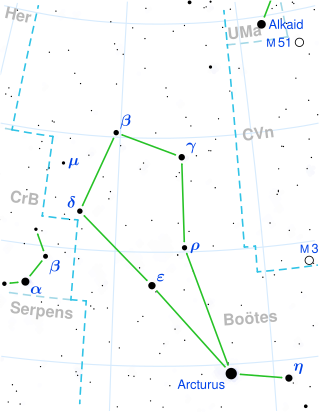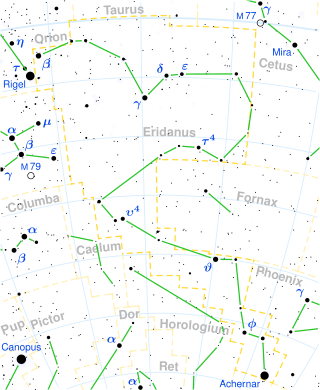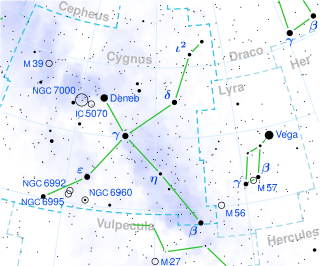
8 Andromedae, abbreviated 8 And, is a probable triple star system in the northern constellation of Andromeda. 8 Andromedae is the Flamsteed designation. It is visible to the naked eye with an apparent visual magnitude of 4.82. Based upon an annual parallax shift of 5.7 mas, it is located about 570 light years from the Earth. It is moving closer with a heliocentric radial velocity of −8 km/s.

Iota Boötis is a member of a binary star system in the constellation Boötes, approximately 96 light-years from Earth. It has the traditional name Asellus Secundus and the Flamsteed designation 21 Boötis. The companion is HD 234121, a K0 main sequence star.

Phi Cassiopeiae is a star in the constellation Cassiopeia. φ Cassiopeiae is a multiple star with a combined apparent magnitude of +4.95. The two brightest components are A and C, sometimes called φ1 and φ2 Cas. φ Cas A is an F0 bright supergiant of magnitude 4.95 and φ Cas C is a 7.08 magnitude B6 supergiant at 134".

Omicron1 Centauri is a star in the constellation Centaurus. It is approximately 10,000 light years from Earth.

9 Vulpeculae is a star in the northern constellation of Vulpecula, located about 560 light years away based on parallax. It is visible to the naked eye as a faint, blue-white hued star with a baseline apparent visual magnitude of 5.01. The star is moving further from the Earth with a heliocentric radial velocity of +5 km/s.
HD 88836, also known as HR 4019, is a solitary, yellow-hued star located in the southern constellation Antlia. It has an apparent magnitude of 6.32, placing it near the limit for naked eye visibility. Based on an annual parallax shift of 7.019 mas, the object is estimated to be 465 light years away from the Solar System. Its distance from the Sun does not appear to be changing, having a radial velocity of 0 km/s.
HD 156768 is a double star in the southern constellation of Ara, with a combined apparent magnitude of 5.86. The brighter component is a sixth magnitude bright giant or supergiant star with a stellar classification of G8Ib/II. The magnitude 9.6 companion lies at an angular separation of 1.81″ along a position angle of 184°.

HD 158476 is a supergiant star in the southern constellation of Ara. There is a faint magnitude 10.5 companion at an angular separation of 20.0″ along a position angle of 209°.
HD 135438 is a K-type giant star in the northern constellation of Boötes. With an apparent magnitude of 6.0, it lies about 650 light years away.
HD 90089 is a star located in the northern circumpolar constellation Camelopardalis. With an apparent magnitude of 5.25, it is faintly visible to the naked eye under ideal conditions. This star is located relatively close at a distance of 75 light years, but is drifting away at a rate of almost 8 km/s.

f Eridani is a binary, or possibly a triple, star system in the equatorial constellation of Eridanus, consisting of stars HD 24071 and HD 24072. They share a single Hipparcos catalogue entry, HIP 17797, but have separate Bright Star Catalogue listings, HR 1189 and 1190. f Eridani is the Bayer designation of the pair.

V529 Andromedae, also known as HD 8801, is a variable star in the constellation of Andromeda. It has a 13th magnitude visual companion star 15" away, which is just a distant star on the same line of sight.

QW Puppis is a class F3V star in the constellation Puppis. Its apparent magnitude is 4.49 and it is approximately 69.5 light years away based on parallax.

1 Puppis is a single star in the southern constellation of Puppis. It lies in the northern part of the constellation at a distance of about 790 ly, east of Aludra in Canis Major and just north of the white supergiant, 3 Puppis. This object is visible to the naked eye as a faint, red-hued star with an apparent visual magnitude of 4.59. It is moving further from the Earth with a heliocentric radial velocity of +32.4 km/s.

HD 59890 is a class G3Ib yellow supergiant star in the constellation Puppis. Its apparent magnitude is 4.65 and it is approximately 1,360 light years away based on parallax.

31 Cygni, also known as ο1 Cygni, Omicron1 Cygni, or V695 Cygni, is a triple star system about 750 light years away in the constellation Cygnus.
7 Tauri is a multiple star in the northern constellation of Taurus. It has a combined apparent visual magnitude of 5.95, so, according to the Bortle scale, it is faintly visible from suburban skies at night. Measurements made with the Gaia spacecraft show an annual parallax shift of 5.5 mas, which is equivalent to a distance of around 593 light years from the Sun.
HD 10455, also known as HR 4595, is a star located in the southern circumpolar constellation Octans. It has an apparent magnitude of 6.02, allowing it to be faintly visible to the naked eye. Based on parallax measurements from Gaia Data Release 3, it is estimated to be 336 light years distant. It appears to be receding from the Solar System, having a heliocentric radial velocity of 17.1 km/s.

RS Sagittarii is an eclipsing binary star system in the southern constellation of Sagittarius, abbreviated RS Sgr. It is a double-lined spectroscopic binary with an orbital period of 2.416 days, indicating that the components are too close to each other to be individually resolved. The system has a combined apparent visual magnitude of 6.01, which is bright enough to be faintly visible to the naked eye. During the primary eclipse the brightness drops to magnitude 6.97, while the secondary eclipse is of magnitude 6.28. The distance to this system is approximately 1,420 light years based on parallax measurements.

HD 22764, also known as HR 1112, is an orange hued star located in the northern circumpolar constellation Camelopardalis. It has an apparent magnitude of 5.78, allowing it to be faintly visible to the naked eye. The object is located relatively far at a distance of approximately 1,770 light years based on Gaia DR3 parallax measurements but is approaching the Solar System with a heliocentric radial velocity of −12.5 km/s. At its current distance, HD 22764's brightness is diminished by 0.66 magnitudes due to interstellar dust.












